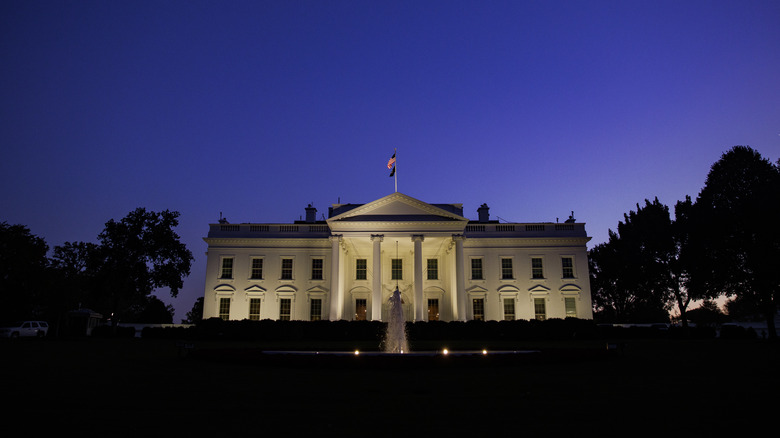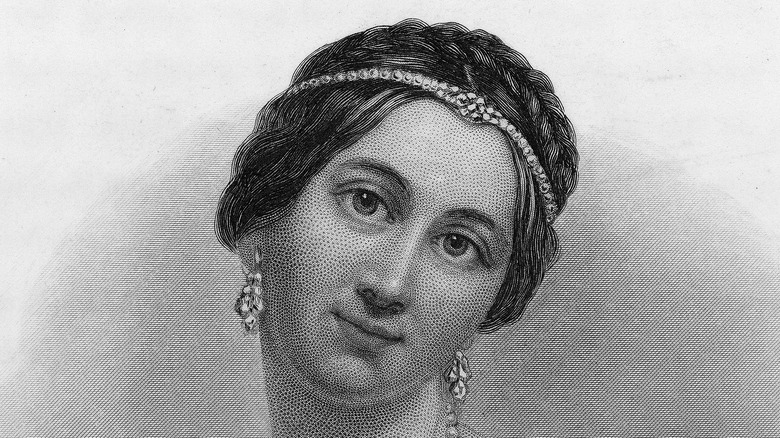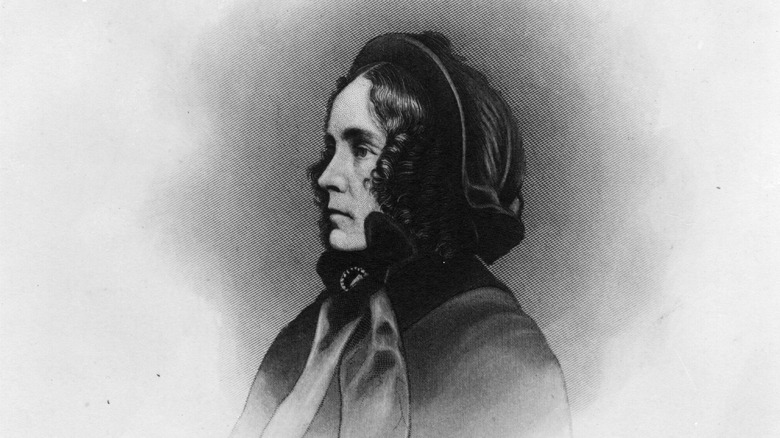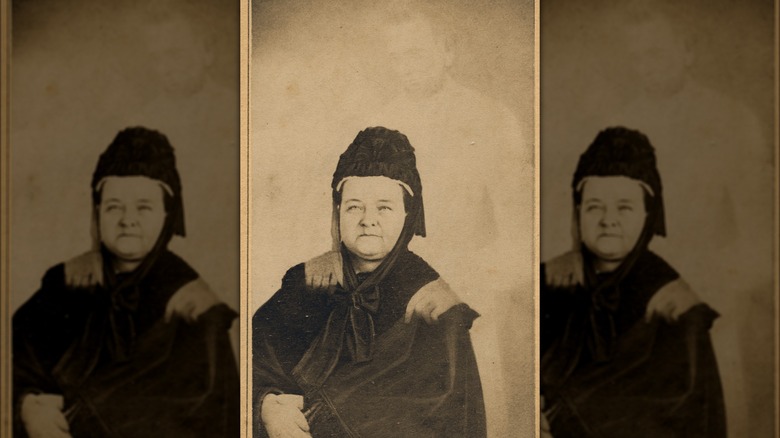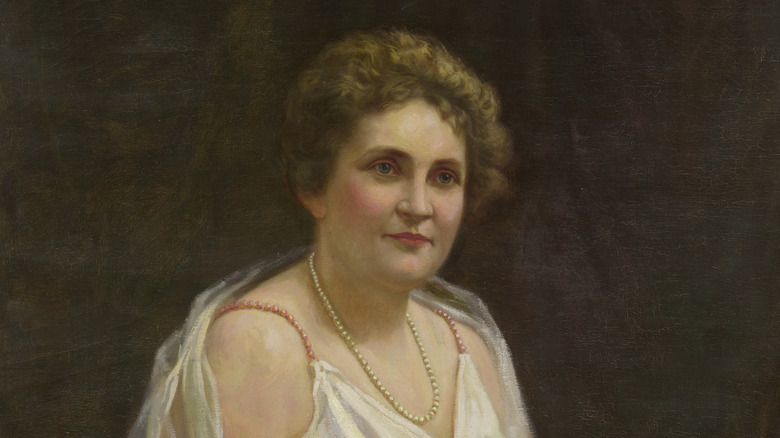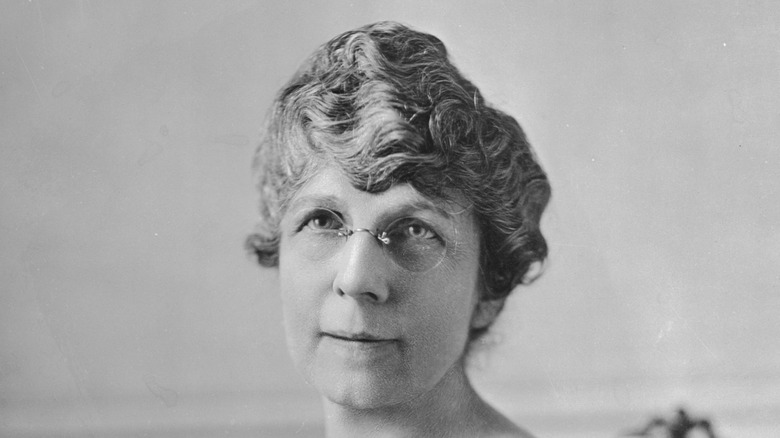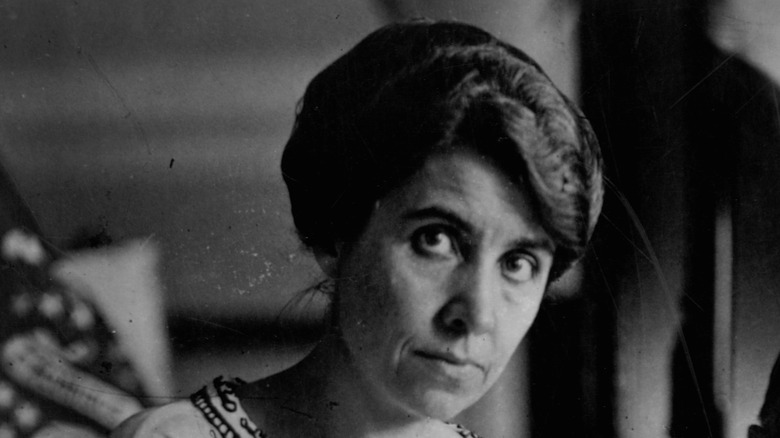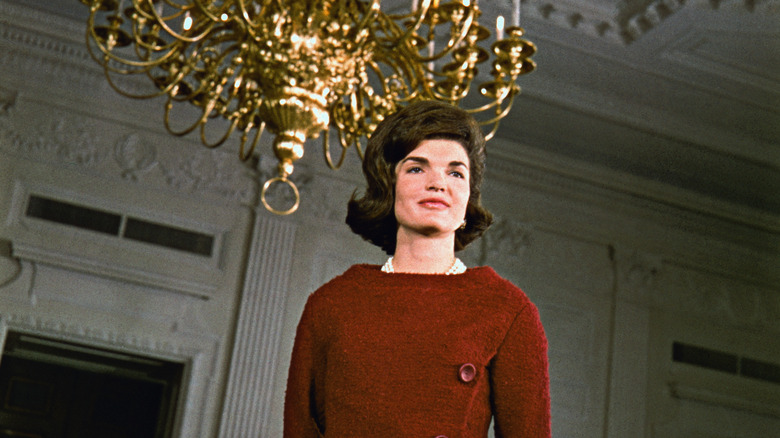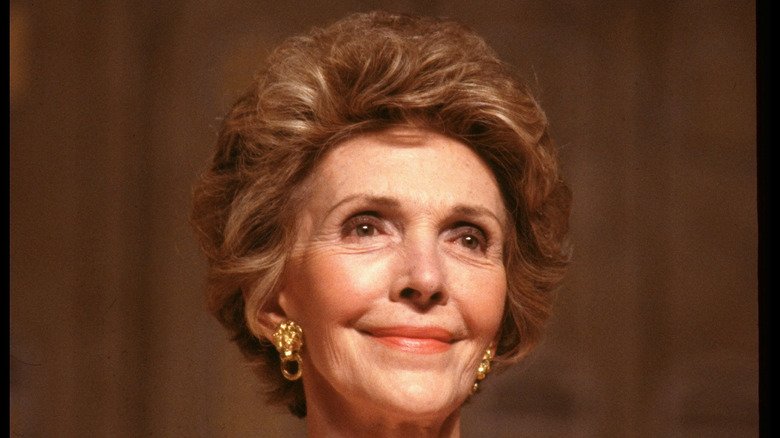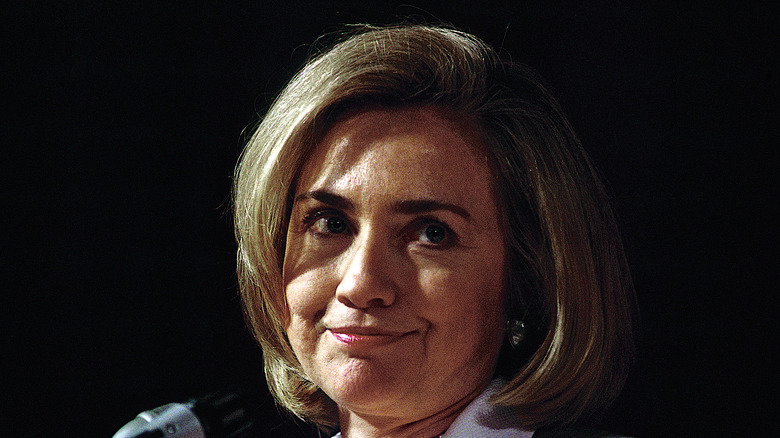First Ladies Who Were Involved In The Occult
The image of the first lady of the United States is all too often a rather sedate picture. The wife of a sitting president — currently, no first gentleman has joined this group — is today expected to take on a particular cause or two, pose for photo opportunities, and act as a kind of social emissary for her spouse's administration. Of course, how much a first lady does and just how intensely or not she wields her power varies amongst individuals and administrations. Some have remained downright mysterious figures, while others — such as Edith Wilson — have gotten allegedly close to wielding presidential power.
Sometimes, despite the pressure to remain accessible and appealing to a wide range of people, first ladies have taken part in activities that may be considered less ready for public consumption, at least according to certain members of the public and their spouse's administration. The most eye-catching are surely occult-related activities, whether it's a quiet reading of palms or Tarot cards or more dramatic seances in which the dead were believed to return in order to speak with and comfort their grieving family members. Some were motivated by personal interest, while others may have been following trends brought to the fore by war, disease, and other traumas.
Julia Tyler
Whereas some inhabitants of the White House were more or less content to outsource their occult activities to mediums, astrologers, and the like, Julia Tyler is believed to have taken things into her own hands, at least on occasion. She served as first lady for a seriously short time, from just 1844 to 1845. That's because she married sitting president John Tyler, who had been a widower since the death of his first wife Letitia in September 1842.
While she wasn't exactly a shocking presence while in the White House, Tyler wasn't shy about the occult. She reportedly believed that she possessed paranormal abilities of her own, perhaps influenced by similar spooky leanings from her own mother, who held seances and engaged in an astrological reading from time to time. Tyler was likewise said to have held seances at her post-White House plantation home (though she appears to have leaned somewhat towards the more scientific side of things, believing that common seance phenomena like levitating tables were the result of poorly understood magnetic forces and not ghosts).
She is also said to have gotten a vision of her own husband's death in an 1862 dream. While asleep, Tyler reportedly saw him struggling to breathe in Richmond, Virginia's Exchange Hotel, but upon traveling there, she found him seemingly well and went back home. He died two days later of what may have been a stroke while staying at the Exchange Hotel.
Jane Pierce
One of the earliest known first ladies to have spiritualist connections was Jane Pierce, wife of 14th president Franklin Pierce, who was in office from 1853 to 1857. Jane was sometimes known as the "shadow in the White House," reflecting a gloomy disposition that was sadly well-earned. Even before entering the White House, she was highly skeptical of her husband's campaign, openly hoping that she wished he would lose (Franklin had reneged on an earlier promise not to run for the presidency). After he won, the family suffered tremendous tragedy in 1853, when their 11-year-old son Bennie died in a train derailment. The grief-stricken Jane refused to attend the inauguration and mostly kept to her White House bedroom.
Haunted by the loss of her only surviving child (two other sons died before Bennie), Jane Pierce attempted to contact Bennie via seances and even contacted the infamous Fox Sisters. The sisters commanded public attention for their supposed connections to the world of the spirits, with seances in which the dead were believed to communicate via disembodied knocking (though some of the sisters later admitted to faking their dramatic seances). It's not clear if Pierce went so far as to hold a full seance in the White House, but she was reportedly visited by her young son in a dream afterward, an occurrence that is said to have brought her some measure of comfort in a life that had been indelibly marked by tragedy and a deep, lasting depression.
Mary Todd Lincoln
Of all the first ladies in U.S. history, the most notoriously spooky of them all is surely Mary Todd Lincoln. This was no flippant affectation. Lincoln suffered through the deaths of three sons, including 11-year-old Willie, who tragically died in the White House in 1862 after contracting typhoid fever. She was sitting next to her husband, President Abraham Lincoln, when he was assassinated in Ford's Theatre on April 14, 1865. She was first lady in the bloody, traumatic days of the American Civil War. It's no wonder that she was wracked by grief throughout her life and sought solace in contacting loved ones who might have been waiting for her on the other side.
After Willie's death, Lincoln became known as a devotee of spiritualism and hosted seances in the Red Room of the White House. They were so comforting and powerful that Lincoln began to have spiritual experiences outside of seances. As she told her half-sister, "Willie lives. He comes to me every night and stands at the foot of the bed with the same sweet adorable smile he always has had." She also wrote that brother Eddie, who had predeceased Willie, sometimes came along (via "Mary Todd Lincoln: A Biography").
Well after leaving the White House, Lincoln continued her spiritualist activities, even visiting infamous spirit photographer William Mumler to sit for an 1870 portrait (which supposedly included the spirit of her late husband standing behind her with his hands resting on her shoulders).
Edith Wilson
Edith Bolling Galt clearly knew how to make an impression. She certainly did just that when she appeared one 1915 day before President Woodrow Wilson, who saw her in a White House elevator. Though Wilson was mourning his first wife, Ellen, who had died just the year before, he found that he simply had to introduce himself to the arresting Edith. Soon enough, she became Edith Wilson and moved into the White House for the remainder of her new husband's presidency. When Woodrow suffered a debilitating stroke in October 1919, Edith directed all visitors and important paperwork through her in an attempt to preserve his health, leading to somewhat exaggerated claims that she was effectively the first female president. However, it's hard to deny that she was quite likely the most powerful first lady in American history.
Though Woodrow Wilson is remembered as an especially devout Christian president, that didn't appear to stop Edith from engaging in occult practices from time to time. She was apparently quite fond of one fortune teller in particular, a Washington, D.C. staple who was known as Madame Marcia Champney. While it's said that quite a few of the capital's elites made their way to Champney's townhouse for readings, Wilson invited her into the White House itself (though Champney entered quietly through a less public entrance).
Florence Harding
Though Florence Harding didn't win office herself (despite being very much a part of the women's suffrage movement) husband Warren G. Harding reportedly made it to the White House thanks in part to her energy and ambition. After moving into the mansion in 1921, Florence proved to be an open and accessible first lady, hosting all manner of notables at the White House, championing political and social causes, and advising her husband on affairs of state. But then Warren died of a heart attack in 1923, bringing her time as first lady to an abrupt close. She died late the next year, after years of kidney problems.
In her relatively short time in Washington, D.C., however, Florence Harding became known not just for her political acumen, but her occult leanings, too. She had a favorite fortune teller — Madame Marcia Champney, the very same individual who worked with previous first lady Edith Wilson and who is said to have predicted President Harding's sudden death. She was also believed to have told Florence of her husband's affairs and predicted his win. Though Champney briefly earned the first lady's ire after publicly admitting to being Florence's astrologer, public attention cooled enough for the fortune teller to make her way back to the Harding White House, crystal ball in tow.
Harding was also friends with socialite Evalyn Walsh McLean, who was at the time the owner of the supposedly cursed Hope diamond, which is said to have unnerved the curse-conscious Harding.
Grace Coolidge (maybe)
Grace Coolidge, who served as first lady from 1923 to 1929, was a popular figure in the Washington, D.C. social scene and the U.S. at large. Yet, her time in the White House wasn't all lighthearted parties. Her 16-year-old son, Calvin, Jr., died on July 7, 1924, after a blister on his foot became infected with staphylococcus bacteria and became septic. Though the Coolidges did their best to carry on, rumor had it that they attempted to manage their grief by contacting their son through a seance. At least, that's what Harry Houdini said. The famous stage magician was also an anti-spiritualist crusader who decried mediums and their seances as nothing more than frauds.
While testifying before Congress in 1926 (in an attempt to ban fortune tellers), Houdini claimed that a Washington, D.C. medium told him, "I know for a fact that there have been spiritual seances held at the White House with President Coolidge and his family." Associates of the Coolidges bluntly denied the claim, though it would have been understandable, given their grief and the broader renewed interest in spiritualism after World War I and the 1918 influenza pandemic.
If Grace Coolidge's seance cred is a bit spotty, there's at least one other occult-like element to her time in the White House. She is the first known person to have claimed a sighting of Abraham Lincoln's ghost in the residence, reporting that she saw his shade pensively looking out a window of the Oval Office.
Eleanor Roosevelt
Eleanor Roosevelt is often depicted as a highly intelligent and deeply admirable first lady — and rightly so. Though she entered the White House as the wife of Franklin D. Roosevelt for his four terms as president from 1933 until his death in 1945, Eleanor made a name for herself as an author, activist, and diplomat who eventually became a beloved figure in American history.
Perhaps less well-known are her run-ins with the occult. Like quite a few upper-class women of the time, Roosevelt wasn't above consulting mediums or fortune tellers. In her case, that was an Indiana palm reader known as Nellie Simmons Meier, who herself became so famous during the 20th century that she was sometimes called the Palmist to the Stars and even read FDR's palm (he responded by calling her "the most interesting woman to visit the White House in years," per the Encyclopedia of Indianapolis). Franklin also invited mentalist Joseph Dunninger to perform at the White House, an occasion which apparently quite unnerved Eleanor when Dunninger was said to have gotten a bit too accurate in his mind-reading act.
Eleanor is also one of the small group of first ladies who may have had ghostly encounters in the White House. She reportedly felt an eerie presence while working in the Treaty Room — which happened to be an old office of Abraham Lincoln. However, Roosevelt was careful not to call it a ghost outright, despite the many tales of White House ghosts.
Jacqueline Kennedy
During her time as first lady during President John F. Kennedy's term from 1961 until his assassination on November 22, 1963, Jacqueline Kennedy was one of the most visible figures in American politics, from being a style icon to giving a still-famous 1962 tour of the White House televised on CBS (which won her an Emmy), to acting as a champion of history and the arts.
She also reportedly was a believer when it came to many things paranormal, though she hardly publicized this side of her life. Yet she was amongst the rather select group of people who believed that they had experienced an encounter with none other than the long-deceased Abraham Lincoln. According to Jackie's account, whenever she would sit in the mansion's Lincoln Bedroom, she would feel his comforting presence and took it as a protective sign over her and her husband. However, it's worth noting that Lincoln himself didn't actually sleep there, though he did use the second-floor room as an office and meeting space.
Sometimes, Kennedy allegedly took a more direct role in occult-type activities, engaging in her own form of divination via the use of runestones and I Ching. For I Ching, based on a Chinese text said to have been written over 3,000 years ago, Kennedy would have posed a question and tossed a collection of objects — sticks are popular. Looking carefully at the resulting jumble reportedly yields an answer, similar to how runestones would have also been used.
Nancy Reagan
While previous first ladies may have been able to dismiss their visits to astrologers and palm readers as high-society affectations, modern presidential wives haven't been afforded the same luxury. Consider the controversy around Nancy Reagan and her employment of astrologer Joan Quigley. Reagan must have known it would have seemed odd against her and her husband's conservative Christian image. Yet word got out when a former chief of staff claimed Quigley wasn't just a personal favorite of Nancy Reagan's, but a key figure who helped pick favorable meeting dates and even when Air Force One would fly.
It wasn't just that Nancy was regularly on the phone for Quigley's advice; she also paid the astrologer a hefty $3,000 per month. Quigley later claimed that she helped convince Nancy that the Soviets would be open to talks and that President Reagan should connect with U.S.S.R. leader Mikhail Gorbachev. The title of her memoir — "What Does Joan Say?" — was supposedly based on a regular question Ronald Reagan asked of his wife.
Once the astrology revelations were made public, however, the Reagans did some backtracking. White House spokespeople admitted that Quigley's predictions had influenced scheduling, but denied that her work had any influence on policy decisions. And though it was clear that Nancy was interested in the subject — especially when it came to her husband's safety after a 1981 assassination attempt — they claimed that it was little more than a distraction for their real work in government.
Hillary Clinton (kind of)
As a modern first lady, not to mention a former secretary of state and Democratic Party nominee for president, it's little wonder that Hillary Clinton has been subject to some harsh rumors and wild conspiracy theories after spending so much of her life in the public eye. Perhaps going back to the overemphasized occult connections she supposedly had back in the '90s now seems like a breath of fresh air in comparison. Still, being accused of communing with the spirit of fellow first lady Eleanor Roosevelt is one of the odder accusations that have been levied against Clinton over the years.
When the story broke in 1996, it centered on Clinton's meeting with Dr. Jean Houston, a psychologist with, as some have alleged, New Age leanings. Together, the two worked on a visualization in which Clinton imagined conversations with notable figures like Roosevelt or Mahatma Gandhi in order to complete work on a nonfiction book. Yet some publications took it a step further and billed these thought exercises as little more than seances.
Houston herself told The New York Times that the allegations she held a seance with Clinton were nonsense. "I have never been to a seance," she said, dismissing the whole affair as little more than news outlets looking for a made-up sensation. However, Houston did approach more out-there stances, telling the publication, "My whole life has been devoted to pushing the membrane of the possible, to push the boundaries of human capacity."
